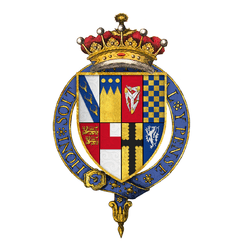Edward Stanley, 3rd Earl of Derby


Edward Stanley, 3rd Earl of Derby KG (c. 10 May 1509 – 24 October 1572) was an English nobleman.
At the age of thirteen, Edward received the titles and estates of his father, the 2nd Earl of Derby, and King Henry VIII took responsibility for bringing him up until he was of age. His commissioners, including Cardinal Thomas Wolsey were responsible for most of his affairs.
In 1528, he accompanied Cardinal Wolsey on a mission to France, and in 1530, he was one of the peers who gave Pope Clement VII the declaration regarding Henry's divorce from Catherine of Aragon. That same year Thomas Howard, 3rd Duke of Norfolk bought the remaining year of Edward Stanley's wardship and married him, without the King's permission, to his daughter, Katherine Howard. The King rebuked Norfolk, but allowed the marriage. Katherine fell victim to the plague a few weeks later. Undeterred, Norfolk arranged for a marriage between his half sister, Dorothy Howard, and Edward Stanley,[1] with whom he had issue:
- Henry Stanley, 4th Earl of Derby
- Isabel (1533–1590) wife of James Stanley
- Jane (d.1569) wife of Edward Sutton, 4th Baron Dudley
- Mary (d.1609) wife of Edward Stafford, 3rd Baron Stafford
- Thomas, grandfather of Venetia Stanley
- Anne, wife of Charles Stourton, 8th Baron Stourton, then John Arundell
- Margaret (d.1585), widow of John Germin & 2nd wife of Sir Nicholas Poyntz (d.1585/6) of Iron Acton, Glos.[2]
In 1532, Edward accompanied King Henry to Boulogne, where they met with King Francis I of France. After this meeting, Edward became a Knight of the Bath. A few years later, Edward took a major role in quelling the Pilgrimage of Grace, a large (mainly church-related) rebellion started in Lincolnshire and spread into North England. In 1542, Edward accompanied the Duke of Norfolk on a raid into Scotland.
When Edward VI ascended to the throne in 1547, Edward became a Knight of the Garter, and in 1550, he was one of the peers who were present at the peace proceedings with Scotland and France. A year later, various charges were brought against him (with little or no evidence), mainly due to his opposition to clerical reform. However, when Queen Mary ascended to the throne, he was again in favour, and was appointed Lord High Steward and became a Privy Councillor. He was a commissioner of Lady Jane Grey's trial, and was frequently present during the trials of accused heretics. He remained in favour under Queen Elizabeth I's reign, and remained on her Privy Council. She eventually appointed him Chamberlain of Chester.
Edward Stanley died at Lathom House, and his titles and estates were passed on to his eldest son, Henry Stanley.
Ancestry
Footnotes
- ↑ Knafla 2008
- ↑ Heralds' Visitation of Glos. 1623, p.135, Poyntz
References
- Knafla, Louis A. (2008). Stanley, Edward, third earl of Derby (1509–1572), magnate. Oxford Dictionary of National Biography.
- Zevin, Edward M. (2010). The Life of Edward Stanley, Third Earl of Derby: Noble Power and the Tudor Monarchy. Edwin Mellen Press.
External links
| Honorary titles | ||
|---|---|---|
| Preceded by Unknown |
Lord Lieutenant of Lancashire 1552–1572 |
Succeeded by The Earl of Derby |
| Preceded by Unknown |
Vice-Admiral of Lancashire 1569–1572 | |
| Preceded by Unknown |
Lord Lieutenant of Cheshire Vice-Admiral of Cheshire 1569–1572 | |
| Head of State of the Isle of Man | ||
| Preceded by Thomas Stanley |
Lord of Mann 1521–1572 |
Succeeded by Henry Stanley |
| Peerage of England | ||
| Preceded by Thomas Stanley |
Earl of Derby 1521–1572 |
Succeeded by Henry Stanley |
| Baron Strange (descended by acceleration) 1521–1559 | ||